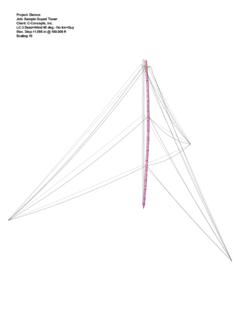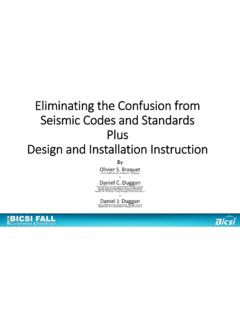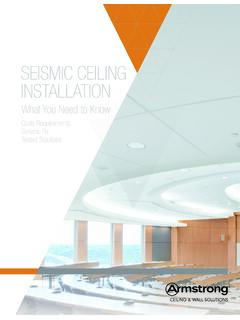Transcription of ANSI/TIA-222-G Explained - Tower Analysis and Design …
1 1 Tower Numerics Inc. ANSI/TIA-222-G Explained John R. Erichsen, , Introduction ANSI/TIA-222-G -2005 A big change the biggest since 1986 9 years of Work Published August 2005 Addendum 1 published October 2006 Addendum 2 published by January 2008 2 Revision G Philosophy Why Change? New Technology Engineering Theory LRFD vs. ASD Explicit Impact Controversial LRFD is not universally used ASD has not been updated since 1989 A merged LRFD and ASD manual may appear in the future Computing Resources Implicit impact Increase computing power allows greater calculation/programming sophistication Research Implicit Impact Bracing capacity - ERI Wind Tunnel Studies - PiRod Greater Understanding of Wind Loads - EUROCODE Revision G Philosophy Why Change?
2 Building Code Consolidation Simplify building permit process nationally Unify the application Development of the IBC Consolidation of SBC UBC BOCA 3 Revision G Philosophy Why Change? Changes in Environmental Loads New Wind Speed Measurement Techniques Shift from Fastest mph to 3-Second Gust Government Mandated Change Development of National Ice Loads ASCE-7 05 will make ice loads mandatory Study now covers the entire United States seismic Loading May govern in very special circumstances Revision G Philosophy Why Change? A desire by the Main Committee to improve buyer/user confidence Eliminate the interpretations that may not be compatible with theory or the intent of the standard Define the rules. Less reliance on Engineering Judgment Acknowledgement that revision F did not always allow the user/buyer to make a confident competent comparison of competing designs Raise the bar Create an International Standard (IASS Moscow Feedback) 4 Loads Different Type Developing a Wind Load Classify the structure by use and risk -Classification will adjust the return period.
3 -How will the structure be used (Ham Operation vs. 911)? -What is the risk to life and Property (Located in a urban environment vs. Rural)? What is the local environment? -Exposure to wind (surface roughness). Exposure Categories: B, C, and D. -Topography (flat or on top of a hill). Topographic Categories 1 through 5. 5 Return Periods Class I 25 year return Period Probability of occurrence in one year = Importance Factor, I = Creates a wind pressure that is 13% less than Class II, (7% decrease in windspeed) 24% less than Class III (13% decrease in windspeed) Class II 50 year return Period Probability of occurrence in one year = Importance Factor, I = Creates a wind pressure that is 13% Greater than Class I, (7% increase in windspeed) 15% less than Class III, (7% decrease in windspeed) Class III 100 year return Period Probability of occurrence in one year = Importance Factor, I = Creates a wind pressure that is 13% Greater than Class II, (7% increase in windspeed) 24% Greater than Class I (13% increase in windspeed)
4 Exposure Categories Exposure B Urban and Suburban Wooded Areas Filled with Obstructions the Size of Single Family Dwellings Must surround the structure at least 2,630 ft or 10 times the structure height in all directions whichever is greater 6 Exposure Categories Exposure C Open terrain with scattered obstructions having heights generally less than 30 ft [ m]. This category includes flat, open country, grasslands and shorelines in hurricane prone regions. Exposure Categories Exposure D Flat, unobstructed shorelines exposed to wind flowing over open water (excluding shorelines in hurricane prone regions) for a distance of at least 1 mile [ km]. Shorelines in Exposure D include inland waterways, lakes and non-hurricane coastal areas. Exposure D extends inland a distance of 660 ft [200 m] or ten times the height of the structure, whichever is greater.
5 Smooth mud flats, salt flats and other similar terrain shall be considered as Exposure D. 7 Wind Shift from Fastest mph to 3-second Gust wind speed Government changed the measurement standard in the early 1990 s (ASCE 7-95) Conversion Factors Wind 8 Wind Wind on Ice & Ice Ice map is developed for Glaze only. It does not include Rime Ice An analytical estimate based upon computer modeling and empirical observations The Wind on Ice and Ice thickness listed cannot be separated. The model is based upon a wind mechanism that drives ice accumulation. Lower winds will result in a different ice thickness and vice versa. 9 Wind on Ice & Ice importance factors shift the ice loading return periods in the same manner as the 3-second gust wind speed. is a defined requirement.
6 Ice can be ignored. close attention to special wind regions indicated by the shaded areas. values represent zones. No interpolation. attention to the notes in the figure. Northwest Columbia River Basin Lake Superior Region Alaska Terrain Features (Topography) EIA Standard has adopted the 5 categories defined by ASCE However, the calculations were simplified. Escarpment 2-D Ridge or 3-D Axisymmetrical Hill 10 Terrain Features Category 1: No abrupt changes in general topography, flat or rolling terrain, no wind speed-up consideration shall be required. Category 1 No Impact, Terrain Features are ignored. Terrain Features Category 2: Structures located at or near the crest of an escarpment. Wind speed-up shall be considered to occur in all directions. Structures located on the lower half of an escarpment or beyond 8 times the height of the escarpment from its crest, shall be permitted to be considered as Topographic Category 1.
7 Structures A & B Category 1 Structures C & D Category 2 Category 1 No Impact, Terrain Features are ignored. 11 Terrain Features Category 3: Structures located in the upper half of a hill. Wind speed-up shall be considered to occur in all directions. Structures located in the lower half of a hill shall be permitted to be considered as Topographic Category 1. Structures A & B Category 1 Structures C & D Category 3 A hill is a rise from average terrain in all directions. Category 1 No Impact, Terrain Features are ignored. Terrain Features Category 4: Structures located in the upper half of a ridge. Wind speed-up shall be considered to occur in all directions. Structures located in the lower half of a ridge shall be permitted to be considered as Topographic Category 1.
8 Structures A & B Category 1 Structures C & D Category 4 A ridge is a rise from average terrain in two directions. Category 1 No Impact, Terrain Features are ignored. 12 Terrain Features Category 5: Wind speed-up criteria based on a site-specific investigation. For topographic category 5, Kzt shall be based on recognized published literature or research findings. Use IBC or ASCE 7-05 13 Topographic Features Escarpment Hill Ridge Default Environmental Values As listed in ANNEX A: PROCUREMENT AND USER GUIDELINES Default Structure Class: II Exposure Category C Topographic Category 1 Assume the guy elevations are equal to the base elevation Default seismic Site Class D (Stiff Soil) 14 Antenna Loads Area calculations derived utilizing a standardized approach Less latitude for the designer.
9 Must include antenna pipes Depends on the direction under consideration Design Wind Force on Appurtenances The Design wind force on appurtenances (either discrete or linear but excluding microwave antennas), FA, shall be determined from the equation: FA = qz Gh (EPA)A Where (EPA)A = Ka[(EPA)N cos2( ) + (EPA)T sin2( )] (EPA)N = (Ca AA)N (EPA)T = (Ca AA)T Equivalent flat plate areas based on Revision C of this Standard shall be multiplied by a force coefficient, Ca, equal to except when the appurtenance is made up of round members only, a force coefficient of may be applied. Appurtenances 15 Appurtenances Wind Speed Domains Subcritical Reynolds Numbers, Re < x 105 Transitional - x 105 Reynolds Numbers, Re x 105 Supercritical Reynolds Numbers, Re > x 105 Subcritical Supercritical 16 Windspeed Domain Subcritical to Transitional to Supercritical Exposure B Windspeed Domain Subcritical to Transitional to Supercritical Exposure C 17 Windspeed Domain Subcritical to Transitional to Supercritical Exposure D Appurtenances Carrier Type No ice Ice ti [ti 13 mm] Ice < ti [13 < ti 38 mm] Transmission Lines (EPA)A ft2 [m2] Wt kips [kN] (EPA)A ft2 [m2] Wt kips [kN] (EPA)A ft2 [m2] Wt kips [kN] Light (9 antennas max) 55 [ ] [ ] 75 [ ] [ ] 110 [ ] [ ] (9) 1 5/8 in.
10 Diameter ( in. [51 mm] OD) Heavy (12 antennas max) 80 [ ] [ ] 100 [ ] [ ] 135 [ ] [ ] (12) 1 5/8 in. diameter ( in. [51 mm] OD) Defined Default Cellular Antenna Areas for bids 18 Line Loads LINE LOADS CAN NO LONGER BE CONSIDERED AS PART OF THE SECTION AREA! It is an appurtenance. No longer a distinction between discrete and linear The designer will utilize the same force coefficients, Ca, factors that are applied to antennas, and other discrete appurtenances. Line Loads Triangular Cross Section Square Cross Section Sheltering: Based upon voids ratio (1- ) Only applicable to sub-critical flow. Sheltering effects allowed when the line loads are entirely on the inside of the structure or is outside the cross section of the and entirely within the face zone.







